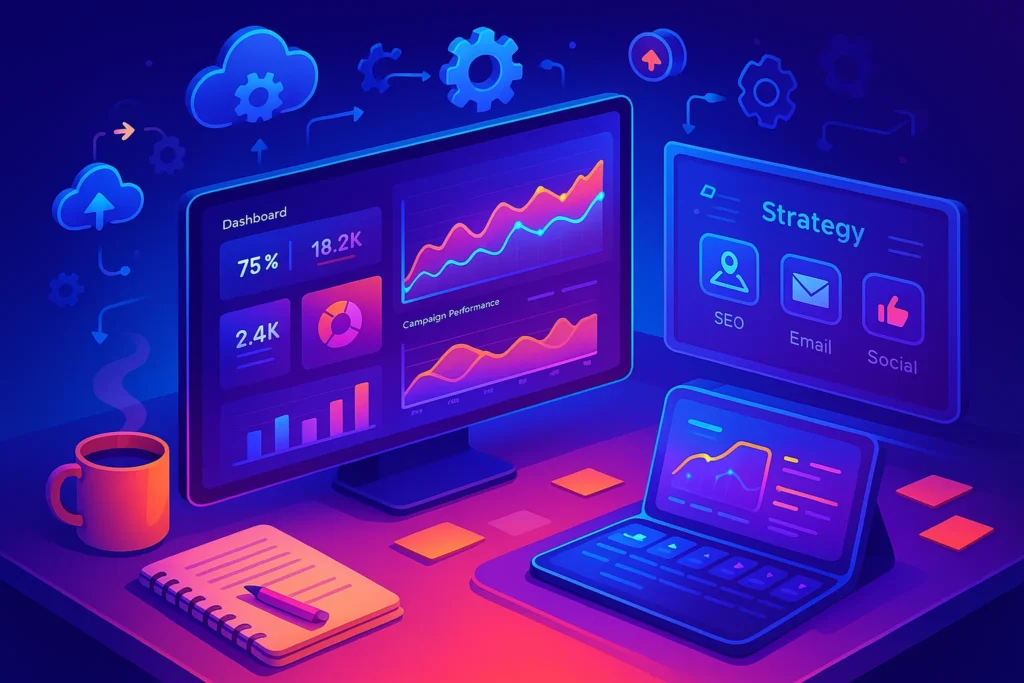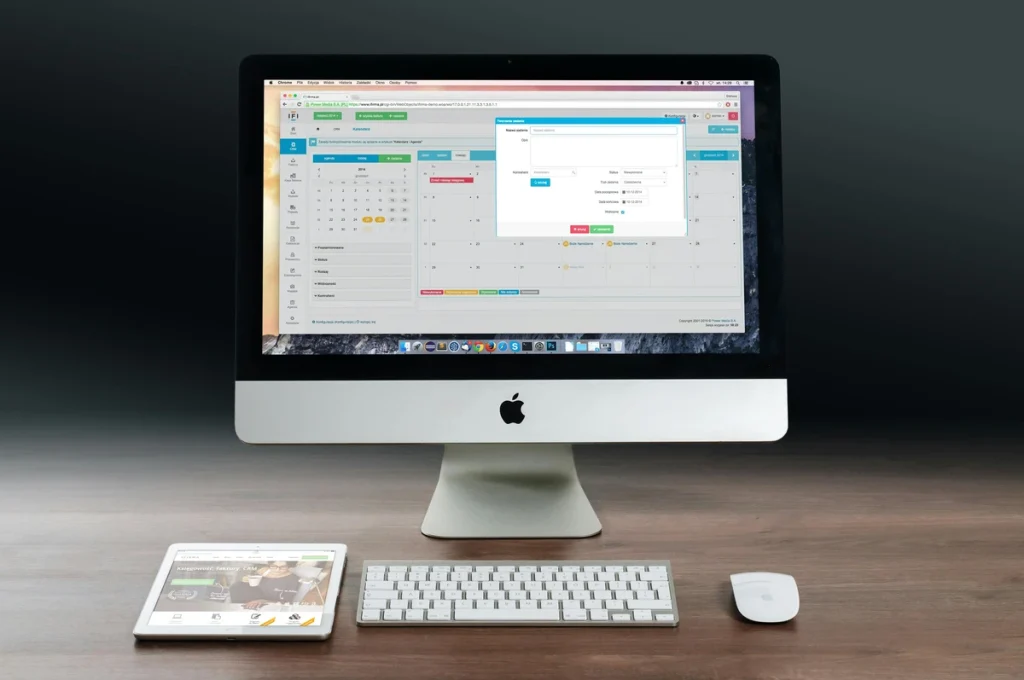Intro:
Marketing analytics are the heartbeat of every growth strategy — but manually building reports every week is like re-inventing the wheel. Whether it’s SEO performance, social media engagement, email marketing open rates, or paid ad ROI, the insights matter. The time spent compiling them? Not so much.
The good news: report automation in 2025 has evolved beyond static spreadsheets. We now have real-time dashboards, AI-driven summaries, and cross-platform integrations that turn hours of reporting into minutes — without sacrificing accuracy or depth.
In this guide, we’ll break down exactly how to automate your marketing reports with modern tools, workflows, and templates so you can spend less time collecting data and more time acting on it.
🧠 Why Automating Your Marketing Reports is Non-Negotiable in 2025
Manually creating reports might feel safe — you have control over every number — but it’s a hidden productivity drain. If your marketing team spends even 4 hours a week creating reports, that’s over 200 hours a year lost to repetitive work.
Automation solves this in three major ways:
-
Time Efficiency — A one-time setup creates recurring reports forever.
-
Accuracy — Automation reduces human error from copy-paste workflows.
-
Scalability — Adding new channels or metrics is as simple as updating your data source.
For example, if you’re running Social Media Marketing campaigns, you can integrate your analytics into a central dashboard that automatically fetches engagement data from X, Instagram, and LinkedIn every morning. Not only does this free up hours, but it also gives you real-time performance visibility — something static monthly reports can’t.
💬 Think of automation not as “doing less work,” but as “doing more impactful work with the same time.”
🎯 Step 1 — Define Your Reporting Goals
Before choosing tools, get clear on what decisions your reports need to support. This will dictate which metrics, sources, and formats matter most.
Example:
-
If your priority is SEO growth, you’ll want to include keyword rankings, organic traffic trends, and conversion rates.
-
If your focus is paid ads, you’ll prioritize CPC, CPA, and ROAS.
This clarity ensures you’re not drowning in irrelevant metrics.
While defining goals, think in actionable terms:
-
“I want to know which campaigns to scale up” → include ROI metrics.
-
“I want to identify underperforming channels” → include cost-per-result and engagement benchmarks.
💡 In our guide to SEO in 2025, we explain why modern search analytics must track beyond rankings, including SERP features and AI Overviews.
🛠 Step 2 — Choose the Right Automation Tools
The market is crowded, but not all tools are equal. Your choice depends on data sources, team size, and budget.
Popular Picks in 2025:
-
Google Looker Studio — Best free option with unlimited data source integrations.
-
Supermetrics — Excellent for pulling data from multiple marketing platforms into Google Sheets, Excel, or Looker Studio.
-
Databox — Perfect for agencies managing multiple clients; beautiful, mobile-friendly dashboards.
-
HubSpot Reports — Great if you already use HubSpot for CRM and inbound marketing.
-
Klipfolio PowerMetrics — Real-time KPI tracking for distributed teams.
💬 Nerd Tip: Match your automation tool to your existing workflow. If your team already lives in Google Sheets, adding Supermetrics might be smarter than introducing a brand-new dashboard platform.
💡 Our AI-Powered Marketing article covers how AI is enhancing reporting tools with natural language summaries and predictive analytics.
🔄 Step 3 — Integrate All Your Data Sources
Automation only works if your tools are connected to all the platforms you rely on — otherwise, you’ll still need manual exports.
Key sources to connect:
-
Website analytics (Google Analytics 4, Adobe Analytics)
-
SEO platforms (Ahrefs, SEMrush, Moz)
-
Social media (X, Instagram, LinkedIn, Facebook)
-
Email marketing (Mailchimp, ActiveCampaign, HubSpot)
-
Ad platforms (Google Ads, Meta Ads, LinkedIn Ads)
-
Content platforms (WordPress, Shopify blog, YouTube Studio)
The goal is a single source of truth — one dashboard where decision-makers see the full picture without toggling between tabs.
💬 Once you integrate, test each connection by checking a live metric (e.g., today’s clicks) to confirm it matches the native platform.
💡 When setting up your content KPIs, our Content Marketing Platforms guide explains how to sync blog analytics with your ad and social dashboards.
🎨 Report Design Matters
A well-automated report isn’t just a wall of numbers — it should be immediately readable and decision-friendly. That’s where formatting comes in.
Best practices:
-
Use traffic light indicators (green for growth, red for decline).
-
Group metrics by channel for easy scanning.
-
Include trend graphs for key metrics to show direction, not just numbers.
-
Add a brief AI-generated summary for executives who don’t have time to analyze raw data.
“A good automated report answers questions before they’re asked — and raises the right ones you didn’t think to ask.” — Data-Driven Marketer, 2025
📐 Step 4 — Schedule and Automate Delivery
Don’t just build the report — make sure it lands in the right inbox or Slack channel at the right time.
-
For weekly marketing meetings: send Monday 9 AM.
-
For executive summaries: send the first of each month.
-
For ad optimization teams: daily snapshots at 7 AM.
Most tools allow you to export PDFs, share live dashboard links, or even embed reports in project management tools like Notion or Asana.
💬 Your report’s timing should match the rhythm of your decision-making — too frequent and it’s noise; too rare and it’s outdated.
🧠 Step 5 — Add Automated Insights with AI
In 2025, automation isn’t just about pulling numbers — it’s also about understanding them instantly. AI-powered analytics can now scan your data and produce plain-English takeaways, like:
-
“Your CPC dropped 18% compared to last week — likely due to increased ad relevance.”
-
“Organic traffic from LinkedIn increased 32% month-over-month; consider boosting content on this channel.”
Where to use AI in reporting:
-
Trend detection — Spot anomalies before they become problems.
-
Performance summaries — Write automated executive digests.
-
Predictive analytics — Suggest budget reallocations based on historic ROI.
💡 In our Pro Tips for Effective Email Management, we show how AI can analyze open-rate patterns and recommend optimal send times.
💬 Let your AI reporting assistant highlight “what’s next,” not just “what happened.”
💬 Step 6 — Maintain and Update Your Automations
Even the most elegant automated report can break if:
-
APIs change
-
A data source gets disconnected
-
Your marketing priorities shift
Set a quarterly audit to:
-
Check if all integrations still pull accurate data.
-
Add/remove metrics based on new campaigns.
-
Update visualization styles for clarity.
This habit ensures your reports remain relevant, trustworthy, and actionable.
📬 Automate Your Marketing Reports Like a Pro
Join our free weekly newsletter and get exclusive breakdowns of automation tools, ready-to-use templates, and workflow blueprints used by top marketers.
No fluff — just actionable strategies to save hours and impress your clients or team.
🔐 100% privacy. No spam. Only high-value marketing automation tips from NerdChips.
🧩 Advanced Workflow Examples — Real-Life Marketing Report Automations
Sometimes seeing how others actually do it sparks the exact idea you need.
Here are three automation setups from different business types, showing how they pull, analyze, and present data without lifting a finger.
1️⃣ Digital Marketing Agency – Multi-Client Dashboards
Goal: Give 15+ clients weekly performance snapshots without drowning in manual work.
Workflow:
-
Data Sources: Google Ads, Facebook Ads Manager, LinkedIn Campaign Manager, Google Analytics 4.
-
Automation Tool: Google Looker Studio (connected via Supermetrics API).
-
Trigger: Weekly — every Monday at 9 a.m.
-
Output:
-
Traffic overview
-
Conversions & CPA per platform
-
Ad creative performance breakdown
-
-
Delivery: Auto-generated PDF sent via email to each client.
💡 Nerd Tip: Agencies also integrate Slack webhooks so account managers get notified if a campaign’s CPC spikes unexpectedly.
2️⃣ SaaS Company – Product-Led Growth Reporting
Goal: Monitor how new features impact acquisition, activation, and retention in real time.
Workflow:
-
Data Sources: Mixpanel (product analytics), Google Analytics 4, HubSpot CRM, Stripe (billing).
-
Automation Tool: Power BI (with custom SQL queries).
-
Trigger: Daily — at midnight for fresh overnight data.
-
Output:
-
Feature adoption funnel
-
Trial-to-paid conversion rate
-
Churn indicators
-
-
Delivery: Internal dashboard updated automatically, plus AI-generated Slack summaries for leadership.
💡 If you’re tracking AI-Powered Marketing, you can use similar AI tools to summarize retention risks and upsell opportunities.
3️⃣ eCommerce Brand – Cross-Channel Sales Performance
Goal: See how ads, organic content, and influencer marketing contribute to sales.
Workflow:
-
Data Sources: Shopify, Google Ads, TikTok Ads Manager, Klaviyo (email).
-
Automation Tool: Databox.
-
Trigger: Real-time sync every 15 minutes.
-
Output:
-
ROAS per channel
-
Best-performing product SKUs
-
Email revenue contribution
-
-
Delivery: Live dashboard for marketing & operations teams, displayed on a big screen in the office.
💡 Nerd Tip: Use conversion tags on all influencer links to measure ROI and avoid overpaying low-impact partners.
💬 Steal one of these workflows, swap in your tools, and you’ll have your first automated report running in under a day.
🧠 Advanced Automation Scenarios for Different Marketing Roles
Automation isn’t one-size-fits-all — the way you design your reporting workflows depends heavily on your role and goals.
-
Social Media Teams can integrate tools like Sprout Social or Buffer with Google Data Studio to merge data from X, Instagram, LinkedIn, and TikTok into one unified KPI dashboard. This eliminates the need to manually log in to each platform and compile engagement stats.
-
SEO Specialists can automate weekly ranking and keyword trend updates by pulling data from Google Search Console and Ahrefs API directly into a master spreadsheet or Looker Studio report.
-
Ad Campaign Managers can combine data from Google Ads, Meta Ads, and LinkedIn Campaign Manager into a single performance report, complete with ROAS (Return on Ad Spend) and CPC trends, for faster decision-making.
💬 Nerd Tip: If you’re running multi-channel campaigns, design separate “focus views” in your automated reports — one for daily monitoring and one for monthly strategic reviews.
📊 ROI Tracking & Attribution in Automated Reports
One of the biggest advantages of automated reporting is the ability to connect ROI metrics and attribution modeling directly into your dashboards.
Instead of just showing “clicks” and “impressions,” integrate your reports with your CRM or sales platform. This way, you can track exactly which campaigns or channels are delivering actual revenue.
For example, connecting Google Analytics 4 with HubSpot or Salesforce can help you create a live-updating “Revenue by Channel” chart, so you instantly see whether organic traffic, paid ads, or email campaigns are performing best.
✅ Why this matters: Marketing teams can make faster, data-driven decisions and stop wasting money on underperforming channels.
⚠️ Common Mistakes in Marketing Report Automation (and How to Avoid Them)
Even the best automation systems can fail if they’re set up incorrectly. Here are the most common mistakes — and how to avoid them:
-
Incomplete Data Feeds: If an API connection breaks or your credentials expire, your reports will be missing crucial metrics. Always schedule periodic connection checks.
-
Irrelevant KPIs: Automating vanity metrics like “total page likes” may clutter reports without adding decision-making value. Focus on metrics that tie directly to business goals.
-
Outdated Report Templates: Platforms change their algorithms and data structures frequently. If you don’t update your report templates, you risk inaccurate or misleading results.
🧩 Fix it: Build a quarterly “report audit” into your process to ensure your automation setup is still relevant and accurate.
🔄 Building a “Report Once, Use Everywhere” System
Many teams waste time creating separate reports for each audience — one for managers, one for clients, one for internal teams. Instead, design a single master report that can serve multiple purposes.
This can be done by:
-
Creating role-based filters in tools like Looker Studio, so each viewer only sees the data relevant to them.
-
Using dynamic date ranges so the same report works for both daily snapshots and quarterly summaries.
-
Adding custom notes or annotations for different stakeholders without changing the base data.
💬 Nerd Tip: A “report once, use everywhere” setup saves hours every month, improves consistency, and ensures everyone works from the same source of truth.
🛡 Security & Privacy Considerations in Automated Marketing Reports
Automated reports often contain sensitive campaign and customer data. Treat them like you would treat any other confidential business asset.
-
Restrict API Access: Only allow integrations with trusted tools and limit permissions to the data you actually need.
-
Encrypt Data in Transit: Use secure connections (HTTPS, SSL) for data transfers between platforms.
-
Remove Personally Identifiable Information (PII): If client names, email addresses, or phone numbers are not needed for analysis, exclude them from the automated report entirely.
✅ Why this matters: Data leaks not only damage trust but can also lead to legal consequences under regulations like GDPR and CCPA.
🧠 Nerd Verdict
Automating your marketing reports isn’t just a productivity hack — it’s a strategic advantage. When your insights arrive faster, cleaner, and in real time, you can pivot campaigns sooner, capture fleeting opportunities, and spend your energy on growth, not grunt work.
Teams that adopt robust reporting automation today will outpace competitors still trapped in spreadsheet hell.
❓ FAQ: Nerds Ask, We Answer
💬 Would You Bite?
If you could automate one report that eats up most of your time, which would it be — and why?
Drop your answer in the comments — your pain point might inspire our next automation guide. 👇



